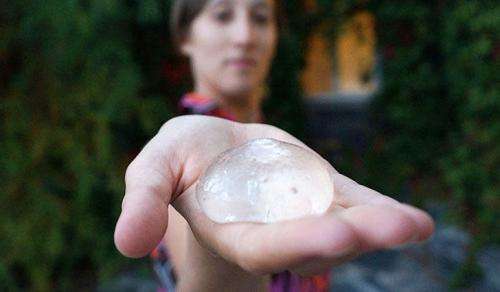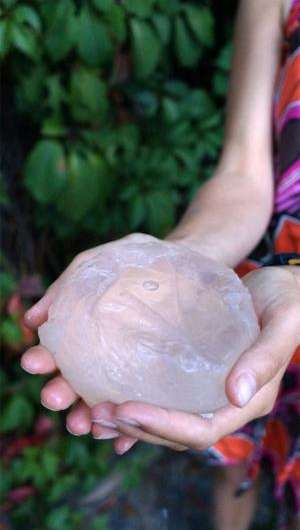(Phys.org) —Think about it. A Sunday in the park. Trashbins overflow with plastic water bottles cast off by joggers, power walkers and their cheering supporters. They have gone home after a charitable athletic event to raise money for—you guessed it—the environment. Are we going nowhere very fast? A water container called the Ooho is a potential option; it is biodegradable and edible. The Ooho was created by three designers and has been named one of 12 winners of the Lexus Design Award 2014. This is an international design competition, where 1,157 submissions were received during the application period and from that group, 12 winners were selected after consideration by six judges. One may describe this entry as a water ball or more specifically as membrane packaging for liquids. Rodrigo García Gonzalez, Pierre Pasalier, and Guillaume Couche are the designers. After all, are plastic bottles the choice containers for water? The designers came up with a holder for water in the form of a double membrane. The process they used is known as "spherification," a technique used in culinary circles for shaping liquids into sphheres resulting in artistic presentations of food that look like magical jewels.
The technique dates back to lab work in the 1940s. In more recent times. Spanish chef Ferràn Adria brought the technique to highly creative modern cuisine at his restaurant elBulli. The Ooho ingredients are water, calcium chloride and brown algae. The Ooho team applied the concept not to elegant caviar or pea soup renderings but to water. Their project involved their experimenting with different portions and dimension of their brown algae, calcium chloride and water ingredients and they developed a suitable double gelatinous membrane. An estimated cost to make this water ball is not exactly prohibitive—two cents a unit. The double membrane protects the inside hygienically, one of the designers said in Fast Company.
A report on the team's efforts in designboom, the digital architecture and design magazine, said the inspiration for their entry came from nature's way of encapsulating liquid using membranes, as in the egg yolk. The Ooho team succeeded in creating their edible membrane as an alternative to the plastic water bottle. To achieve their double gelatinous membrane they used sodium alginate from the brown algae and calcium chloride in proportions that could generate gelification.
While companies have the infrastructure to manufacture packaging, according to the report in designboom, the main idea of Ooho "is that everyone could make them at their kitchen, modifying and innovating the 'recipe.' From DIY to CIY (Cook It Yourself)."
More information: www.designboom.com/project/ooho/
© 2014 Phys.org
























